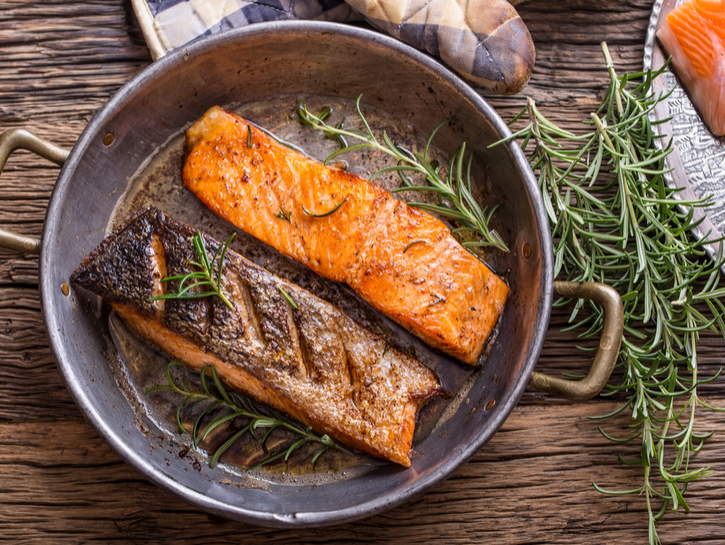Salmon is a fish known for its mild, non-fishy taste and pink coloring. Whether served with asparagus and rice on the side or roasted with lemons and dill, the dish is always popular. But what about the brownish-gray skin that coats part of your fillet? What are you supposed to do with that? Wonder no longer — we’ve got you covered on everything you need to know about salmon skin.

Marian Weyo/Shutterstock
Can You Eat Salmon Skin?
Eating the skin is not only doable, but it’s recommended. Salmon skin is tasty and provides a lot of flavor and texture to this more mild-tasting fish. The skin also helps the salmon retain moisture and nutrients as it’s cooked.

vanillaechoes/Shutterstock
Are There Health Benefits Of Eating Salmon Skin?
On top of being a good source of protein, salmon is one of the best sources of omega-3 fatty acids. These acids have been linked to reducing heart disease, high blood pressure, arthritis and high cholesterol. Because of the fish’s health benefits, the Food and Drug Administration recommends eating two to three servings of salmon a week.
Most of the omega-3 fatty acids are located in the salmon skin, so removing it strips away most of the nutritional benefits.

Marian Weyo/Shutterstock
Are There Health Risks Of Eating Salmon Skin?
While salmon skin is generally safe and healthy to eat, there are some risks for eating the skin of salmon that has been contaminated. A common source of salmon contamination is from chemicals called polychlorinated biphenyls, or PCBs, which salmon can absorb through their skin. Humans who eat salmon skin contaminated with PCBs can experience harmful effects to their immune system, reproductive system, and nervous system, according to the Environmental Protection Agency. PCBs have also been linked to cancer and, if eaten by pregnant women, birth defects.
However, PCB contamination is more prevalent in Atlantic farmed salmon than wild salmon, according to a 2004 study by Indiana University. So if you have a craving for salmon, you might want to check that it isn’t farmed.

its_al_dente/Shutterstock
How To Cook Salmon
Salmon is a versatile dish that can be prepared in numerous ways:
Pan Frying
- Season your salmon with salt and pepper
- Add a little butter or olive oil to a skillet and warm over medium-high heat
- Place the salmon in the skillet, skin side up
- Let cook for 5 to 6 minutes without touching it
- Flip the salmon over with a spatula and let it cook 3 minutes skin side down
- Remove from heat, sprinkle with lemon juice and serve
Roasting
- Preheat oven to 400 degrees
- Season salmon with salt and pepper
- Place skin side down in a greased baking dish or sheet pan
- Bake for 12 to 15 minutes
Unlike with pan frying, there is no need to flip your salmon when you roast it. You can also bake your salmon in parchment or tin foil — salmon en papillote. For this method:
- Preheat oven to 400 degrees
- Add fish, seasonings and flavorings (such as lemon slices or dill) to parchment or foil
- Close the parchment or foil, making an envelope around the food
- Bake for 12 to 15 minutes
- Remove the covering and serve

Magrig/Shutterstock
Grilling
- Place the seasoned and oiled salmon skin side down onto the grill
- Let cook for 3 to 5 minutes before flipping. If the flesh is sticking to the grill, cook for a minute or two longer.
- Once flipped, cook for another 3 to 5 minutes until cooked through
Before grilling, you can also prepare a salmon marinade to enhance the flavor of the fish
Poaching
- Fill a pot with enough water to cover the salmon fillets
- Bring the water to a simmer
- Add the salmon and cover the pot
- Turn the heat off and let the salmon cook for 25 minutes
